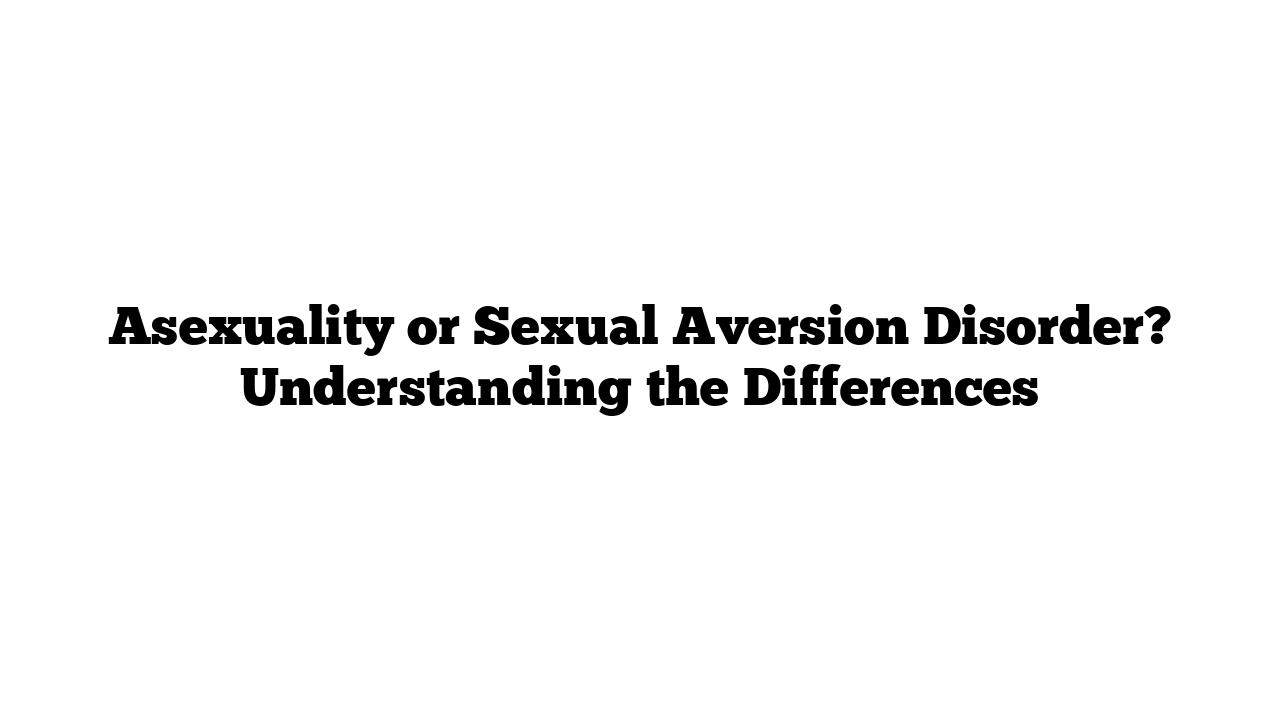Sexuality—the capacity for sexual feelings—is a fascinating and complex aspect of human experience. However, it can become even more intricate when someone doesn’t feel sexual attraction at all. For some individuals, this lack of attraction may point to asexuality, a valid and natural sexual orientation.
Yet, in certain cases, this absence of attraction might stem from underlying issues, such as Sexual Aversion Disorder (SAD). These two experiences, while seemingly similar, are distinct and often difficult to differentiate. Understanding their differences can help in navigating emotions and seeking appropriate support.
What is Asexuality?
Asexuality is a sexual orientation characterized by a lack of sexual attraction toward others. Asexual individuals, often called “aces,” may still engage in romantic relationships, feel emotional connections, and desire companionship.
A key aspect of asexuality is that individuals typically feel at peace with their lack of sexual attraction. While societal norms may occasionally challenge their orientation, many asexual people embrace their identity with acceptance.
What is Sexual Aversion Disorder (SAD)?
Sexual Aversion Disorder is a condition where individuals experience an intense aversion to sexual activity. Unlike asexuality, SAD involves significant distress, fear, or anxiety about sexual interactions. These feelings can lead to avoidance of sexual activity and negatively impact relationships and mental health.
The Diagnostic and Statistical Manual of Mental Disorders (DSM) describes SAD as a persistent or recurrent extreme aversion to and avoidance of sexual contact. This reaction goes beyond disinterest and is often tied to psychological factors, such as trauma, anxiety, or negative associations with sex.
Key Signs: Is It Asexuality or SAD?
1. Reaction to Sexual Stimuli
How do you feel when exposed to a romantic or sexual scene on TV or a flirty message from someone?
- Asexuality: Individuals generally feel neutral or uninterested in sexual content. They might avoid such themes simply because they don’t find them engaging, not because they are repulsed.
- SAD: Those with SAD may experience intense anxiety, tension, or even panic at the thought of sexual interactions. The reaction stems from fear or discomfort rather than a simple lack of interest.
2. Psychological Patterns
Research provides helpful insights into distinguishing the two experiences. A 2021 study examined how asexual individuals and those with sexual disorders responded to sexual and non-sexual images.
- Asexuality: Participants showed little attention to sexual imagery, reflecting a natural disinterest.
- SAD: Individuals with SAD initially focused on sexual images but felt discomfort, suggesting they retained some interest but were hindered by emotional barriers.
This highlights that interest in sex-related topics might still exist in SAD, whereas asexuality involves little to no inherent attraction.
3. Emotional Well-being
Feelings of distress or anxiety can also differentiate asexuality from SAD.
- Asexuality: Most aces report high levels of self-acceptance and are generally unbothered by their orientation. While challenges like societal expectations or romantic misunderstandings may arise, they typically embrace their identity.
- SAD: Those with SAD often feel burdened by their lack of desire. A 2015 study found higher levels of psychological distress and depression among individuals with sexual desire disorders compared to asexual participants. SAD sufferers may wish to experience sexual attraction but feel unable to, leading to frustration and diminished self-esteem.
4. Onset of Symptoms
The timeline of sexual experiences can provide critical clues.
- Asexuality: This orientation is usually lifelong. Asexual individuals often describe never having felt sexual attraction, even in adolescence when peers began experiencing crushes and sexual interest.
- SAD: Symptoms of SAD are more likely to appear after a period of sexual attraction or activity. This change may result from trauma, negative experiences, or emotional challenges, making it vital to explore potential triggers with a mental health professional.
How to Navigate Your Feelings
If you’re questioning your feelings about sexual attraction, reflecting on your experiences and emotions can be a helpful first step. Consider the following:
- Lifelong Patterns: Have you always felt disinterested in sexual activity, or did this aversion develop later?
- Emotional Reactions: Do sexual situations evoke anxiety, fear, or discomfort?
- Psychological Impact: Does your lack of sexual desire cause you distress, or are you content with it?
Seeking Support
Regardless of whether you identify as asexual or believe you may have SAD, professional guidance can provide clarity and relief.
- For Asexuality: Exploring resources like support groups or online communities can help you connect with others who share your experiences.
- For SAD: A licensed sex therapist or mental health professional can help uncover the root causes of discomfort and work toward healing.
Embrace Yourself
Remember, your feelings and experiences are valid. Whether you identify as asexual or believe your struggles stem from SAD, you deserve love, respect, and understanding. Taking steps to understand your emotions is a powerful act of self-care.
Reference Website:
Top 10 FAQs About Asexuality and Sexual Aversion Disorder
- Can someone be both asexual and have Sexual Aversion Disorder?
Yes, though it’s rare. Asexuality is an orientation, while SAD is a mental health condition. - How do I know if I’m asexual or have SAD?
Reflect on your emotional reactions to sexual situations and seek professional help for clarity. - Is asexuality a medical condition?
No, asexuality is a valid sexual orientation and not a disorder. - What causes Sexual Aversion Disorder?
SAD can result from trauma, anxiety, or negative associations with sex. - Can SAD be treated?
Yes, therapy and counseling can help address underlying causes. - Do asexual people date?
Many asexual individuals date and form deep, romantic relationships without sexual attraction. - Are there support groups for asexuality?
Yes, organizations like AVEN (Asexual Visibility and Education Network) offer resources. - Can SAD resolve on its own?
It’s unlikely. Professional support is typically needed for lasting improvement. - How common is asexuality?
Research estimates about 1% of the population identifies as asexual. - Is it okay to not feel sexual attraction?
Absolutely. Every individual is unique, and your feelings are valid.
